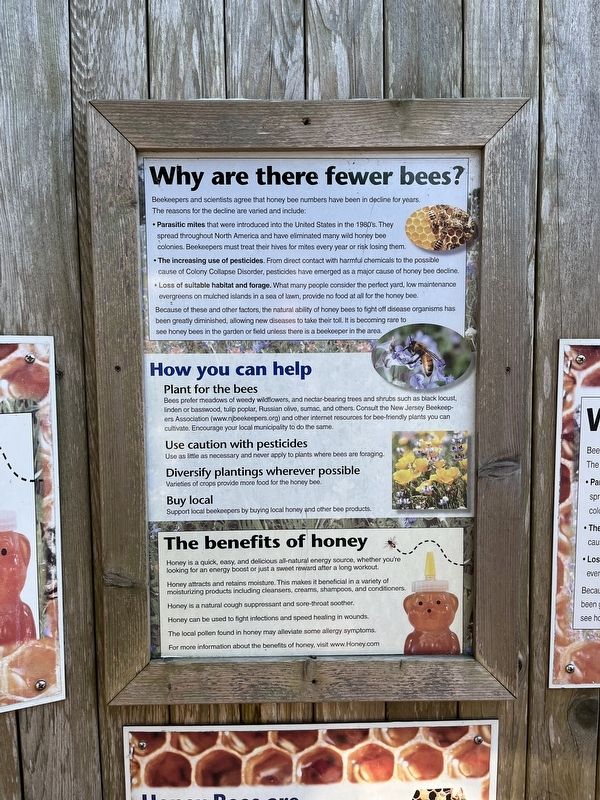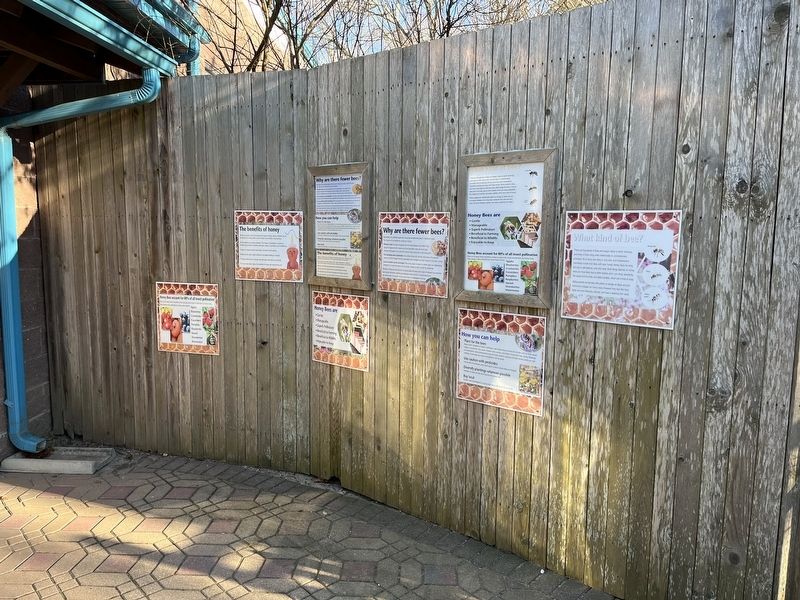Cape May Court House in Middle Township in Cape May County, New Jersey — The American Northeast (Mid-Atlantic)
Why are there fewer bees? / How you can help / The benefits of honey

Photographed By Devry Becker Jones (CC0), January 22, 2022
1. Why are there fewer bees? / How you can help / The benefits of honey Marker
Why are there fewer bees?
Beekeepers and scientists agree that honey bee numbers have been in decline for years. The reason for the decline are varied and include:
• Parasitic mites that were introduced into the United States in the 1980's. They spread throughout North America and have eliminated many wild honey bee colonies. Beekeepers must treat their hives for mites every year or risk losing them.
• The increasing use of pesticides. From direct contact with harmful chemicals to the possible cause of Colony Collapse Disorder, pesticides have emerged as a major cause of honey bee decline.
• Loss of suitable habitat and forage. What many people consider the perfect yard, low maintenance evergreens on mulched islands in a sea of lawn, provide no food at all for the honey bee.
Because of these and other factors, the natural ability of honey bees to fight off disease organisms has been greatly diminished, allowing new diseases to take their toll. It is becoming rare to see honey bees in the garden or field unless there is a beekeeper in the area.
How you can help
Plant for the bees
Bees prefer meadows of weedy wildflowers, and nectar-bearing trees and shrubs such as black locust, linden or basswood, tulip poplar, Russian olive, sumac, and others. Consult the New Jersey Beekeepers Association (www.njbeekeepers.org) and other internet resources for bee-friendly plants you can cultivate. Encourage you local municipality to do the same.
Use caution with pesticides
Use as little as necessary and never apply to plants where bees are foraging.
Diversify plantings wherever possible
Varieties of crops provide more food for the honey bee.
Buy local
Support local beekeepers by buying local honey and other bee products.
The benefits of honey
Honey is a quick, easy, and delicious all-natural energy source, whether you're looking for an energy boost or just a sweet reward after a long workout.
Honey attracts and retains moisture. This makes it beneficial in a variety of moisturizing products including cleansers, creams, shampoos, and conditions.
Honey is a natural cough suppressant and sore-throat soother.
Honey can be used to fight infections and speed healing in wounds.
The local pollen found in honey may alleviate some allergy symptoms.
For more information about the benefits of honey, visit www.Honey.com
Erected by Cape May County Zoo.
Topics. This historical marker is listed in these topic

Photographed By Devry Becker Jones (CC0), January 22, 2022
2. Why are there fewer bees? / How you can help / The benefits of honey Marker
Location. 39° 6.182′ N, 74° 48.943′ W. Marker is in Middle Township, New Jersey, in Cape May County. It is in Cape May Court House. Marker can be reached from County Park Road, 0.3 miles west of North Main Street (U.S. 9), on the left when traveling west. Touch for map. Marker is in this post office area: Cape May Court House NJ 08210, United States of America. Touch for directions.
Other nearby markers. At least 8 other markers are within walking distance of this marker. Why are there fewer bees? (here, next to this marker); Veterans Memorial (a few steps from this marker); Bald Eagle (a few steps from this marker); Elk (Wapiti) (within shouting distance of this marker); De Brazza's Monkey (within shouting distance of this marker); Palm Oil Crisis (within shouting distance of this marker); Camelids (within shouting distance of this marker); Mara's Journey (within shouting distance of this marker). Touch for a list and map of all markers in Middle Township.
Also see . . . 10 Science Mysteries That Have Actually Been Solved. YouTube video:
The section of this video starting on 0:25 states that the disappearance of the bees is specifically tied to the use of neonictinoids, and that framing the issue as complex is a direct result of lobbying in the United States by producers of pesticides. In other parts of the world, the issue is much less complex. (Submitted on March 8, 2022, by Devry Becker Jones of Washington, District of Columbia.)
Additional keywords. invasive species; introduced species
Credits. This page was last revised on February 7, 2023. It was originally submitted on January 24, 2022, by Devry Becker Jones of Washington, District of Columbia. This page has been viewed 364 times since then and 8 times this year. Photos: 1, 2. submitted on January 24, 2022, by Devry Becker Jones of Washington, District of Columbia.